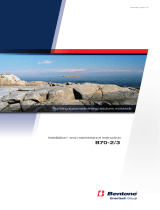
11 171 535 13 06-01
The table applies to oil with a viscosity of 4,4 mm
2
/s (cSt) with density 830 kg/m
3
.
02. TECHNICAL DATA
Nozzle table
3(3)
Gph 10 11 12 13
kg/h kW Mcal/h kg/h kW Mcal/h kg/h kW Mcal/h kg/h kW Mcal/h
2,75 10,24 121 104 10,73 127 109 11,21 133 114 11,67 138 119
3,00 11,16 132 114 11,71 139 119 12,23 145 125 12,73 151 130
3,50 13,03 154 133 13,66 162 139 14,27 169 146 14,85 176 151
4,00 14,89 176 152 15,62 185 159 16,31 193 166 16,97 201 173
4,50 16,75 199 171 17,57 208 179 18,35 218 187 19,10 226 195
5,00 18,62 220 190 19,52 231 199 20,39 242 208 21,22 252 216
5,50 20,48 243 209 21,47 255 219 22,43 266 229 23,34 277 238
6,00 22,34 265 228 23,42 278 239 24,47 290 250 25,46 302 260
6,50 24,20 287 247 25,37 301 259 26,51 314 270 27,58 327 281
7,00 26,06 309 266 27,33 324 279 28,55 339 291 29,70 352 303
7,50 27,92 331 285 29,28 347 299 30,59 363 312 31,83 377 325
8,00 29,79 353 304 31,23 370 318 32,63 387 333 33,95 403 346
8,50 31,65 375 323 33,18 393 338 34,66 411 353 36,07 428 368
9,00 33,59 398 343 35,14 417 358 63,71 435 374 38,19 453 389
9,50 35,37 419 361 37,09 440 378 38,74 549 395 40,31 478 411
10,00 37,23 441 380 39,04 463 398 40,78 484 416 42,44 503 433
11,00 40,96 486 418 42,94 509 438 44,86 532 457 46,68 554 476
12,00 44,68 530 456 46,85 556 478 48,94 580 499 50,92 604 519
14,00 52,12 618 531 54,65 648 557 57,10 677 582 59,41 705 606
16,00 59,57 706 607 62,46 741 637 65,26 774 666 67,90 805 692
18,00 67,02 795 683 70,27 833 717 73,41 871 749 76,39 906 779
20,00 74,47 883 759 78,08 926 796 81,57 967 832 84,87 1007 865
Pump pressure bar
Gph 14 15 16 17
kg/h kW Mcal/h kg/h kW Mcal/h kg/h kW Mcal/h kg/h kW Mcal/h
2,75 12,11 144 123 12,53 149 128 12,95 154 132 13,35 158 136
3,00 13,21 157 135 13,67 162 139 14,13 168 144 14,56 173 148
3,50 15,42 183 157 15,95 189 163 16,49 196 168 16,99 201 173
4,00 17,62 209 180 18,23 216 186 18,84 223 192 19,42 230 198
4,50 19,82 235 202 20,51 243 209 21,20 251 216 21,84 259 223
5,00 22,03 261 225 22,79 270 232 23,55 279 240 24,27 288 247
5,50 24,23 287 247 25,07 297 256 25,91 307 264 26,70 317 272
6,00 26,43 313 270 27,49 326 280 28,27 335 288 29,13 345 297
6,50 28,63 340 292 29,63 351 302 30,62 363 312 31,55 374 322
7,00 30,84 366 314 31,91 378 325 32,98 391 336 33,98 403 347
7,50 33,04 392 337 34,19 405 349 35,33 419 360 36,41 432 371
8,00 35,25 418 359 36,47 433 372 37,69 447 384 38,80 460 396
8,50 37,45 444 382 38,74 459 395 40,04 475 408 41,26 489 421
9,00 39,65 470 404 41,02 486 418 42,40 503 432 43,69 518 446
9,50 41,85 496 427 43,30 514 442 44,75 531 456 46,11 547 470
10,00 44,06 523 449 45,58 541 465 47,11 559 480 47,11 559 480
11,00 48,46 575 494 50,14 595 511 51,82 615 528 53,40 633 545
12,00 52,87 627 539 54,70 648 558 56,53 670 576 58,25 691 594
14,00 62,68 732 629 63,81 757 651 65,95 778 669 67,96 806 693
16,00 70,49 836 719 72,93 865 744 75,38 894 769 77,67 921 792
18,00 79,30 940 809 82,05 973 837 84,80 1006 865 87,38 1036 891
20,00 88,11 1045 899 91,17 1081 930 94,22 1117 961 97,09 1151 990
Pump pressure bar






























